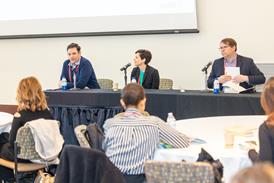- Home
- About CW
-
News
- Back to parent navigation item
- News
- National Compliance Officer Day 2025
- Accounting & Auditing
- AI
- AML
- Anti-Bribery
- Best Practices
- Boards & Shareholders
- Cryptocurrency and Digital Assets
- Culture
- ESG/Social Responsibility
- Ethics & Culture
- Europe
- Financial Services
- Internal Controls
- Regulatory Enforcement
- Regulatory Policy
- Risk Management
- Sanctions
- Surveys & Benchmarking
- Supply Chain
- Third Party Risk
- Whistleblowers
- Opinion
- Events
- Research
- Awards
-
CW Connect
- Back to parent navigation item
- CW Connect
- Sign In
- Apply
- Membership
Debate on Systemic Risk Regulator Begins
By Melissa Klein Aguilar2009-03-18T11:51:00
Related articles
-
Article
Congress Wrestles With Systemic Risk Regulator
2009-03-24T00:00:00Z By Melissa Klein Aguilar
-
 News Brief
News BriefSEC reportedly investigating MassMutual’s accounting amid ongoing government shutdown
2025-10-17T21:09:00Z By Oscar Gonzalez
Even though the U.S. federal government is currently shut down, the U.S. Securities and Exchange Commission appears to still be at work. The financial regulator is reportedly investigating a major insurance and asset management company over its accounting practices.
-
 Webcast
WebcastOct 14 | CPE Webcast: Navigating Evolving Banking Regulations in the U.S. and Canada
Provided by AuditBoard
U.S. Banking regulators have moved to loosen traditional regulation and supervision in areas like capital requirements, stress testing and liquidity, while also being more receptive to innovation in areas including Artificial Intelligence and digital assets.
- Terms and Conditions
- Privacy Policy
- Do Not Sell My Info
- © 2025 Compliance Week
Site powered by Webvision Cloud





